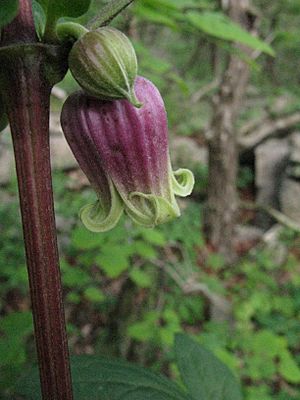Morefield's leather flower facts for kids
Quick facts for kids Morefield's leather flower |
|
|---|---|
 |
|
| by Todd Crabtree | |
| Conservation status | |
| Scientific classification |
Clematis morefieldii is a very rare flowering plant. It belongs to the buttercup family. People also call it Morefield's leather flower or Huntsville vasevine.
This plant grows only in northern Alabama and southern Tennessee. There are about 22 groups of these plants left. Most of these groups are very small. Many are in danger, and some have even disappeared. Because it is so rare, the government listed it as an endangered species in 1992.
Contents
Where It Lives
Discovery of the Plant
This special Clematis plant was found in 1982. A 21-year-old student named James Morefield discovered it. He found it in a vacant lot on Round Top Mountain in Madison County, Alabama. In 1987, scientists officially named it a new species. They named it after James Morefield.
When it was first listed as endangered in 1992, people thought it only grew in Alabama. But later, more plants were found in nearby southern Tennessee.
Its Home
Clematis morefieldii likes to grow in wooded areas. It often grows near streams or wet spots. It is a climbing plant. It uses shrubs and rocks to help it grow upwards. The ground where it lives is very rocky, with lots of limestone and big boulders.
What It Looks Like
Plant Features
Clematis morefieldii has fuzzy vines that can grow up to 5 meters (about 16 feet) long. Its leaves are made up of several smaller leaflets. Each leaf also has one or more tendrils. These tendrils help the plant grab onto things. The underside of the leaflets feels soft and velvety.
Flowers and Fruits
The flowers grow where the leaves meet the stem. Each plant can have up to five flowers. These flowers have pink parts called sepals. The sepals have green tips that curl. The flower looks like an urn and is thick and hairy. It does not have petals. Each flower can be up to 2.5 centimeters (about 1 inch) long.
After the flowers, the plant makes fruits. These fruits can grow up to 3.5 centimeters (about 1.4 inches) long. They have feathery, plume-like tips.
Protecting the Plant
Early Threats
In 1991, when the plant was suggested for endangered status, only five groups of plants were known. Each group was smaller than 1 acre. One group had only a single plant! About 55% of all the plants were on land planned for building. This area was near Huntsville, Alabama, which was growing fast. Three other plant sites were thought to have been destroyed already.
At that time, the main dangers were:
- Building new homes and roads.
- Using chemicals like herbicides.
- People collecting the plants.
Current Situation
By 2010, more than 20 groups of Clematis morefieldii were found. But the plant was still considered endangered. Some groups are now in protected areas, like the Land Trust of North Alabama's Nature Preserves. However, others are in small pieces of habitat surrounded by new buildings.
Most of the old dangers are still there. New threats include:
- Quarrying (digging for rocks) in Tennessee.
- Logging (cutting down trees).
- Non-native plants like exotic honeysuckle vines. These plants can take over the space where Clematis morefieldii grows.
Collecting the plants is not a big problem anymore. Because each group of plants is so small, they are still very likely to disappear. Scientists are doing more research to learn about the plant's life history and how it lives in its environment. They are also looking into insects that might harm it.


